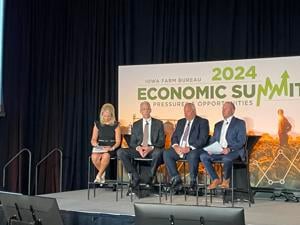The economic pressures facing Iowa agriculture are strong, but experts said there are still reasons to be optimistic during the Iowa Farm Bureau’s annual economic summit on Friday. Farmers and ag stakeholders gathered in Ankeny to hear a forecast of the environment for the industry, which has been volatile in recent years as domestic inflation and global conditions have made costs and returns unpredictable. Don Vaske, a conference attendee who farms in north central Iowa, said he was interested in learning about the trends facing the industry to make the right decisions on his farm.
“It’s always good to have a perspective on past and future trends,” he said. “Basically you don’t want to make the same mistake twice, and we know the farming economy is volatile, and goes up and down.” Farmers have felt the effects of inflation and high interest rates in rising input costs, squeezing their margins and income over the last two years.

Net farm income reached record highs in 2021 and 2022, powered by inflating food costs. Food prices have since cooled while the cost of inputs like fertilizer, machinery and labor have steadily risen, driving down farm income in 2023. That’s led to a high-cost, low-margin environment for most grain producers, said Jim Knuth, a lending executive at Farm Credit Services of America.
That means farmers need to take more proactive measures to ensure their operations remain profitable, Knuth said, like enhancing risk management and crop insu.
















